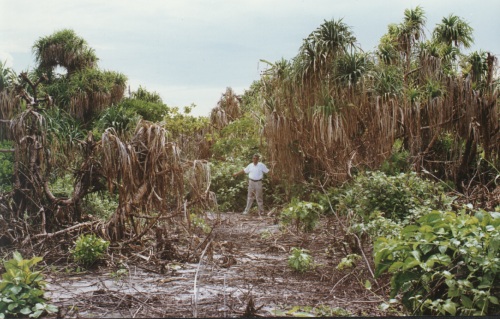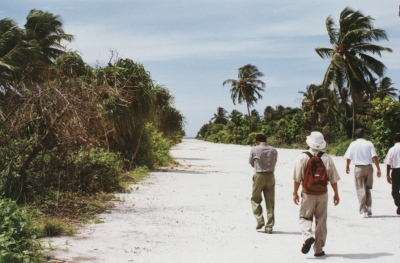Follow this link for real, updated images of the existing observatory.The observatoryInitially, it was planned to transport a fully equipped seatainer to the island of choice and run INDOEX measurements from that. In order to support the local economy and use local services wherever possible, it was decided to have a building and tower build locally, which costs about as much as the previous alternative. 
The initial shelter will be a single stone-house (concrete blocks) with flat roof, large enough to accommodate our currently planned setup with space for more add-ons and will be equipped with everything that is needed such as wooden benches, underbench and overhead shelves and drawers, air conditioner, chairs, electrical wiring with separate circuits (probably 3 x 20 A and options for more), lighting and possibly a small "conference corner" with additional seating. The shelter will be constructed in a way that allows for future expansion if that is necessary and desired. Directional alignment and window orientation will be based on weather and other considerations, the roof will be useable for instrumentation (including guard rail) and will have openings for e.g. FTIR operation. For schematics, see below. 
The Tower (click here to see images of the tower)The scaffolding type tower for 2p radiometric instrumentation and ambient air intakes will be to the east and probably attached to the building with a footprint of about 137 x 305 cm and possibly some guy wiring. The construction will likely be of welded steel, painted for corrosion resistance or, if available, aluminum tubing. The top segment is planned to be acquired in the USA, pre-assembled with all radiometric instruments and then shipped to the observatory for the January 1998 campaign. The overall height of the tower will be 10 m to exceed most of the island’s vegetation and account for future tree growth. A first schematic is available below. Suggestions on design and requirements for the shelter and tower are requested and should be directed to the address mentioned at the top. Here are some detailed schematics of the building (~1100x740 pixels, 200 kb large): Initial setup and instrumentationThe initial setup will include the following confirmed instrumentation:
Other instruments are proposed and will be invited as the project progresses, we will update this list as participation will be confirmed. Maintenance, Transportation, LogisticsOne of the clear disadvantages of Kaashidhooas an observatory site is its distance to Male and, hence, loss of convenience in logistics. However, the Maldivian government has agreed to provide daily maintenance of instrumentation carried out locally by personnel that needs to be trained onsite during the January 1998 setup with re-training during every site visit of C4 personnel. In addition, Mr. Mahmood Riyaz (Assistant Environmental Analyst of MPHRE) will be responsible of 1-2 maintenance trips per week to the island in order to do in-depth instrument checks, data down- and up-load, small repairs and the main communication between INDOEX and Kaashidhoo. Mr. Riyaz will be trained for about one month during the C4 / CARPOS mini-campaign in October 1997. Transportation of Mr. Riyaz and INDOEX personnel and instruments between Male and Kaashidhoo will be provided by the Maldivian government on the MPHRE’s own speed boat and/or a dhoni. Site visits can be arranged on short notice (same day to next day time frame) in case of emergencies. The observatory will be equipped with a dedicated telephone/fax line. Kaashidhoo is one of the island-to-island hops in the Maldivian, micro-wave based phone system (tower seen to the right of the center of Figure 4) and the local phone company can provide a digital link with analog connection to the observatory. C4 plans to have remote phone access to all computers for troubleshooting, software upgrades and data retrieval. Computers inside the observatory will be linked via peer-to-peer ethernet LAN and Windows NT 4.0 Workstation or 95 operating systems. PowerKaashidhoo currently has three power generators build into a new power house that was scheduled to go online shortly after the site survey. The generators create 40, 48 and 58 kW of 220 V, 50 Hz, single phase power. The 48 and 58 kW units are alternately online during the night, the 40 kW unit is on for six hours during the day, with the remaining six hours of no power on the island. This power house setup replaces two stand-alone power units that were operated before. In order to receive 24-hour, uninterrupted power, an agreement was made that C4 will provide a fourth generator (about 56 kW), which can be operated during the day alternating with the 40 kW unit. The INDOEX observatory will initially need around 15 kW of power for the above mentioned instruments including air conditioner. The island chief, Mr. Hussain Moosa, assured us that we will get all the power we need for our operation. However, future needs, particularly during the intensive field phase 99, and expansions to the observatory might require a longer-term strategy that is somewhat different from the current setup. Uninterruptable power supplies are recommended for possible brownout and short blackout periods (switching between generators!) for at least the most sensitive equipment. |